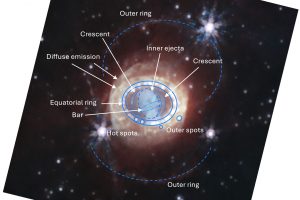The supernova remnant SN 1987A observed by the James Webb Space Telescope

The James Webb Space Telescope, the flagship observatory of NASA/ESA/CSA, has turned its gaze toward the supernova remnant SN 1987A, revealing its structure with an unprecedented level of detail.
About 400 years after Kepler supernova, which exploded in 1604, the skies of the southern hemisphere witnessed another supernova relatively close to us. This was SN 1987A, which exploded on February 23, 1987, in the Large Magellanic Cloud, about 165000 light-years away.
Due to its proximity, SN 1987A has been observed in great detail across the entire electromagnetic spectrum, from radio waves to gamma rays, offering a unique and comprehensive view of the complex high-energy phenomena that occur during a supernova explosion and the subsequent evolution of its remnant. Moreover, it is the only case where telescope observations are available for the progenitor star, the supernova explosion itself, and the formation of the supernova remnant.
The structure of SN 1987A is dominated by three rings: one inner equatorial ring and two outer rings, produced by violent mass ejection events from the progenitor star tens of thousands of years before the explosion. Theoretical models and observations have led to a scenario in which the progenitor, during its red supergiant phase, was part of a binary system. This interaction would have shaped the morphology of the expelled stellar winds, resulting in the characteristic ring-like structures observed today. The progenitor later evolved into a blue supergiant, likely after merging with its companion, and exploded as a supernova shortly afterward.
Observations made with the NIRCam instrument on the James Webb Space Telescope show SN 1987A with unparalleled detail, highlighting regions impacted by shock waves propagating through the supernova remnant. These are traced by emissions from warm dust and synchrotron processes (emission caused by charged particles moving through magnetic fields). These regions are visible in the inner equatorial ring, in the outer rings, and in the diffuse emission zone outside the equatorial ring. The observations also reveal the innermost regions, dominated by the stellar fragments expelled during the explosion (known as ejecta), and a newly observed structure called “the Crescent”. The nature of this new structure is not yet well understood: it could result from the ionization of material associated with the ejecta by high-energy radiation (X-rays and UV) emitted by shocked regions, or it could represent the innermost edge of the reverse shock — the shockwave reflected back inward through the supernova remnant.
The extraordinary NIRCam images of SN 1987A are presented in the article “Deep JWST/NIRCam imaging of Supernova 1987A” by astrophysicist M. Matsuura (Cardiff University), published in the Monthly Notices of the Royal Astronomical Society. Among the co-authors is astrophysicist S. Orlando from the INAF – Osservatorio Astronomico di Palermo.
The cover image (click here to view in full) shows the NIRCam image of SN 1987A, created by combining observations made using five filters, from 1.5 to 4.4 microns, highlighting the main components of the supernova remnant.
Mario Giuseppe Guarcello
Follow MarioSpiegaCose on Instagram () , Facebook (), Youtube (), and X ()
Follow the Astronomical Observatory of Palermo on Facebok and on Instagram
Subscribe the Youtube channel of the Astronomical Observatory of Palermo
